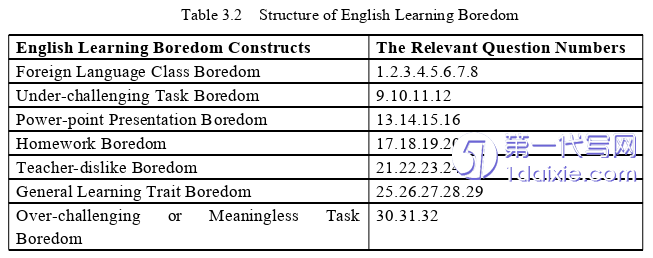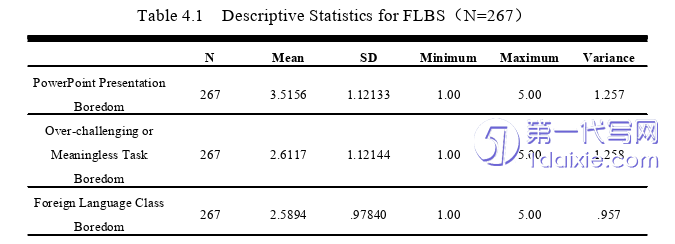本文是一篇英语论文,笔者认为教师应从教学实践出发,采用合理的教学方法,设计合理的教学设计和策略,降低英语学习无聊情绪,激发学生的英语学习动机,从而使得相关教学实践研究得以丰富。
Chapter 1 Introduction
1.1 Background of the Research
With the“affective turn”in applied linguistics research(Pavlenko 2013),thestudy of emotions in language learning has become a new growth point inpsychological research on English learning(Dewaele et al.2019;Li 2021).In studieson learners’academic emotions,scholars have focused on students’anxiety.However,according to Pekrun(2006)classification of academic emotions,anxiety is only ananticipatory emotion that is the result of students’experiences in educational contexts.While there is still a lack of attention to various outcome/retrospective emotions aswell as activity-related emotions,especially negative,low arousal“boredom”.Compared with the research on English anxiety and pleasure emotions,the researchon English learning boredom is still in its infancy,and research on negative emotionssuch as boredom in ELLs may not be available.Many key issues remain to beexplored(Li et al.2022).At the same time,English learning boredom,as aninhibitory negative emotion,seriously hinders the motivation and maintenance ofstudents’English learning and can impact English learning outcomes.However,sinceboredom is a“silent emotion”(Preckel et al.2010),it is extremely easy to beoverlooked by educators and researchers.Studies on boredom have been conducted inthe past.In previous studies,scholars have found that non-English majors experiencea significant level of boredom in English learning.What’s more,this negativeemotion can affect students’professional development and significantly impact theirEnglish performance and interest in learning.Through a review of the literature athome and abroad,it can be found that there are few studies on English learningboredom and motivation.

1.2 Aims and Signnificance
This study employs both quantitative and qualitative research methods,using thecontrol-value theory(CVT)proposed by Pekrun(2006)as the theoretical basis.Thequestionnaires adopted are:1)The English learning motivation questionnaire(Gao etal.2003);2)The Foreign Language Learning Boredom Scale(FLLBS)(Li et al.2021).On the basis of the questionnaire,classroom observations and interviews willbe conducted with some of the study participants.This will investigate the currentsituation of English learning boredom and motivation,the significant correlationbetween non-English majors’English learning boredom and motivation,thepredictive effect of English learning motivation types on English learning boredom,and the predictive effect of English learning boredom on English learning motivationintensity.
Theoretically,it helps to further the knowledge of negative emotions and Englishlearning motivation research and enrich the research results on negative emotions andEnglish learning motivation.In terms of teaching practice,it can assist teachers inunderstanding the current situation of English learning.It can also guide teachers increating a conducive environment for English learning and offer strategies to reducestudent English learning boredom,enhance English learning motivation,and improvestudents’overall engagement with English in educational settings.
Chapter 2 Literature Review
2.1 Control-Value Theory
The concept of Control-value theory(CVT)plays a crucial role in educationalpsychology.It is frequently used to analyze and explain the framework,origins,effects,and outcomes of academic emotions,offering a comprehensive structure forexploring the causes and consequences of students’emotional states.Initially focusingon an expectancy model of learner anxiety,the theory was later extended to includehypotheses about the antecedents of multiple academic emotions and their effects onacademic engagement,self-regulation,and academic achievement.CVT viewsacademic emotions as those evoked by learning processes or outcomes(Pekrun&Perry 2014),and it contains three dimensions of focus,valence and activation.Within this three-dimensional framework,English learning boredom is characterizedas a negative,low-arousal,and process-oriented emotion(Li et al.2021).
2.2 English Learning Boredom
2.2.1 Definition of English Learning Boredom
“English Learning Boredom”is developed from the general concept of boredom,with scholars at home and abroad defining English learning boredom from different perspectives.Some foreign scholars,such as Kruk(2016a),consider English learningboredom to be an unpleasant emotion from low stimulation and low arousal.Pawlaket al.(2022)view English learning boredom as transient and prone to fluctuation,closely related to how students perceive and respond to learning English.Additionally,scholars like Li.&Dewaele(2020)have noted that English learning boredomencompasses both a stable aspect,indicative of habituation and recurrence,and adynamic aspect,characterized by contextuality and transience.Li et al.(2021)introduced the concept of“Foreign Language Learning Boredom,”which pertains toprocess-type negative academic emotions associated with“low physiological arousal”and“low cognitive activation”(Li et al.2021;Pawlak et al.2020c).
2.2.2 Classification of English Learning Boredom
There is considerable attention given to the classification of English LearningBoredom by numerous researchers.Current divisions of English learning boredom arebroadly categorized as follows:Putwain et al.(2018)divide it into two types:stateboredom and trait boredom.Although they are different,it is often assumed thatindividuals with higher levels of trait-type boredom are more likely to experience thecorresponding state-type boredom(Putwain et al.2018).Conversely,an alternativecategorization divides boredom into five distinct types,distinguishing people by thevarying degrees of boredom they encounter.
Chapter 3 Research Design .............................. 20
3.1 Research Questions ................................ 20
3.2 Subjects ................................ 20
3.3 Instruments ........................ 21
Chapter 4 Results and Discussions ................................ 25
4.1 Description of English Learning Boredom and Motivation ............ 25
4.1.1 English Learning Boredom ............................. 25
4.1.2 English Learning Motivation .......................... 30
Chapter 5 Conclusion .......................... 54
5.1 Major Findings ......................... 54
5.2 Pedagogical Implications ............................... 55
5.3 Limitations and Suggestions for Future Studies .............................. 58
Chapter 4 Results and Discussions
4.1 Description of English Learning Boredom and Motivation
The data provided by 267 participants were analyzed with descriptive statistics toreveal the frequency of English learning boredom and English learning motivationamong non-English majors as a whole.
4.1.1English Learning Boredom

As shown in Table 4.1,the mean total score of the English learning boredom was2.4898 indicating that students’English learning boredom is generally at a relativelylow level.To be more specific,among all subjects,the score of PowerPointPresentation Boredom(M=3.5156)was the highest.Other factors are arranged in adescending sequence based on the score:Over-challenging or Meaningless TaskBoredom(M=2.6117),Foreign Language Class Boredom(M=2.5894),Under-challenging Task Boredom(M=2.5258),Homework Boredom(M=2.4554),General Learning Trait Boredom(M=2.2787)and Teacher-dislike Boredom(M=1.6227).This is consistent with the research findings of Mao(2023).However,the subjects in this research presented strong PowerPoint Presentation Boredom andweak Teacher-dislike Boredom.It illustrates that the students themselves were lessinterested in some of the design of the course,but were still generally interested in theinstructor who taught English class.
Chapter 5 Conclusion
5.1 Major Findings
This study explores the relationship between English learning boredom andmotivation.Participants are 267 non-English majors from a science and engineeringuniversity.Two questionnaires,classroom observation,and interviews measuredstudents’English learning boredom and motivation.The main findings of the studyare as follows.
As for the first research question,the descriptive statistical analysis shows thatthe overall English learning boredom of college students is at a low level.Among theseven factors of English learning boredom,students scored highest in PowerPointPresentation Boredom,second in Over-challenging or Meaningless Task Boredom,and lowest in Foreign Language Class Boredom.This is partially consistent with theresearch results of Chai(2023)and Mao(2023).Besides,the motivation types andmotivation intensity of college students are at the middle level.Among the sevenmotivation types,students scored highest in Immediate Achievement,second inInformation Medium,and lowest in Individual Development.
In view of the second question,the correlation analysis shows that there is asignificantly negative correlation between students’English learning boredom andmost motivation types.However,in which there exists a significantly positivecorrelation between English learning boredom and Immediate Achievement.There isa significant negative correlation between every aspect of English learning boredomand motivation intensity.That is,the higher the students’English learning boredom is,the lower the English learning motivation intensity is.
reference(omitted)
